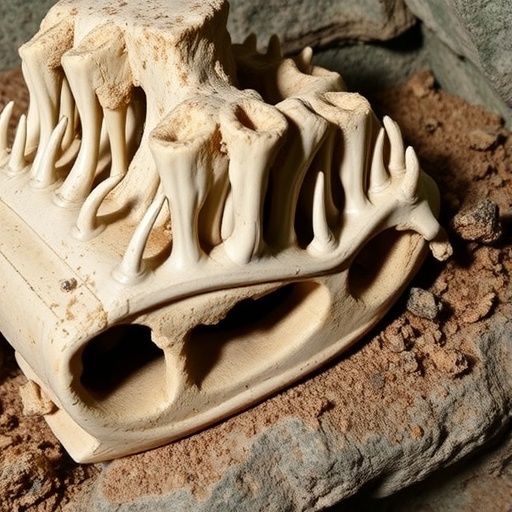Scientists have made a groundbreaking discovery that sheds light on a long-lost Arctic ecosystem dating back approximately 75,000 years. Unearthed in a cave nestled along the northern coast of Norway, the fossilized remains of an extensive animal community have provided an unprecedented window into life during a warmer phase of the last Ice Age. This remarkable assemblage comprises bones from 46 distinct species of animals, encompassing mammals, birds, and fish, and represents the oldest known record of an Arctic animal community in Europe from this critical period.
The excavation site, known as Arne Qvamgrotta cave, was serendipitously discovered in the 1990s during mining operations that tunneled through the surrounding mountain. Although identified three decades ago, the cave remained largely unexplored until recent systematic excavations were undertaken in 2021 and 2022. Through meticulous imaging analysis and stratigraphic excavation techniques, researchers successfully catalogued and dated the fossil remains, enabling a comprehensive reconstruction of the past ecosystem.
The assemblage reveals a diverse coastal environment where marine and terrestrial habitats coexisted. Among the species found are apex predators such as polar bears, as well as marine mammals including walruses and bowhead whales. The presence of seabirds like Atlantic puffins, common eiders, and rock ptarmigans indicates rich avian diversity. Notably, the discovery included collared lemmings, a rodent species now extinct in Europe and hitherto undocumented in Scandinavia, revealing significant shifts in faunal distribution through time.
DNA analyses performed on the fossils have provided critical insights into evolutionary lineage survival and extinction patterns. Genetic evidence shows that the animal populations thriving during this interstadial warm period failed to persist once colder glacial conditions returned. This suggests that these species were highly adapted to temperate Arctic environments and lacked resilience to abrupt climatic reversals. Such findings offer invaluable data points for understanding how climatic oscillations shaped biodiversity in polar regions and inform models predicting species’ vulnerabilities in the face of ongoing climate change.
This ancient ecosystem likely featured a largely ice-free coastal landscape, following the retreat of surrounding glaciers. The diversity of animal remains indicates a complex mosaic of habitats, including freshwater lakes and rivers within tundra landscapes, supporting species such as migratory reindeer. Marine influences shaped the area as well; the presence of freshwater fish and seasonal sea ice zones offered niche environments for both cold-water fish and marine mammals adapted to variable ice cover.
The interrelationship between habitat availability and species survival becomes evident when considering the ecological constraints imposed by fluctuating ice coverage. Species such as bowhead whales and walruses depended on seasonal sea ice, while harbor porpoises, which avoid icy waters, suggest patches of open ocean during warmer months. The persistence and subsequent demise of these animal communities highlight the delicate balance between environmental stability and biological adaptability in frigid ecosystems.
Researchers emphasize the parallels between the past and present, noting that cold-adapted species today face unprecedented challenges in the Arctic’s rapidly warming landscape. Unlike 75,000 years ago, the modern Arctic environment is severely fragmented due to human activities and climate disruption. This fragmentation constrains species’ ability to migrate or adapt to shifting habitats, heightening their risk of local extinctions and ecosystem collapse.
Lead author Dr. Sam Walker of Bournemouth University and the University of Oslo described the discovery as a rare snapshot into a vanished Arctic world. He highlighted how these ancient data broaden our understanding of species resilience and vulnerability to climate extremes. The findings underscore that even cold-adapted species, which once thrived under harsh glacial conditions, can be profoundly susceptible to environmental shifts, a warning that echoes strongly for conservation strategies today.
Senior author Professor Sanne Boessenkool of the University of Oslo noted that prior to this discovery, very little direct evidence existed of Arctic life during this timeframe due to the paucity of preserved remains older than 10,000 years. The cave site’s diverse assemblage now bridges this critical knowledge gap, providing insights into the composition of both marine and terrestrial megafauna during the interstadial period and enriching our paleoclimatic reconstructions.
This study represents a collaborative effort involving institutions such as the University of Oslo, Bournemouth University, the University Museum of Bergen, and the Norwegian University of Life Sciences, among others. Through integrating advanced imaging techniques, DNA sequencing, and multidisciplinary expertise, the research delivers a holistic perspective on Ice Age biodiversity and environmental change in Arctic Europe.
In a broader context, these discoveries reinforce the importance of paleontological and paleoecological studies in deciphering past climate-animal interactions. By understanding how species once responded to dramatic climate fluctuations, scientists can better predict and mitigate the impacts of current and future global warming on fragile Arctic ecosystems and their inhabitants. The revealed fragility of past cold-adapted species underlines the urgency of conservation efforts tailored to protect today’s biodiversity in the face of accelerating environmental transformations.
Subject of Research: Animals
Article Title: Major discovery of Ice Age bones in a Norwegian cave opens a window into the past
News Publication Date: 4-Aug-2025
Web References:
DOI: 10.1073/pnas.2415008122
Image Credits: Credit: Trond Klungseth Lødøen
Keywords: Archaeology, Applied ecology, Aquatic ecology, Ecology, Climatology, Climate change, Paleoclimatology, Behavioral ecology, Ecological dynamics, Ecosystems, Evolutionary biology, Animal migration, Migration tracking, Ecoinformatics, Paleozoology, Biodiversity loss, Biodiversity threats, Habitat diversity, Marine biodiversity, Species richness




